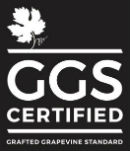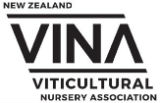Certification




Riversun are members of the New Zealand Viticultural Industry Nursery Association (VINA), which works closely with NZ Winegrowers and were involved in the development of the Grafted Grapevine Standard.
Grafting to the New Zealand Winegrowers Grafted Grapevine Standard (GGS), all grapevine materials used in Riversun’s production of grafted grapevines are carefully selected for their physical characteristics and quality. Vines are also harvested, graded and processed using the HACCP certification system.
The goal of the GGS and HACCP is to provide assurance to growers, viticulturists, winemakers and other stakeholders that the grafted grapevines they purchase are considered “high health” plants.
NZ WINEGROWERS GRAFTED GRAPEVINE STANDARD
Riversun grafts vines to the New Zealand Winegrowers Grafted Grapevine Standard, developed by New Zealand Winegrowers in consultation with viticulture nurseries.
Every aspect of the propagation of Riversun grafted grapevines is intensively audited, with all processes fitting certain criteria to comply with the GGS which is audited annually by NZ Winegrower’s auditors. Download the latest certificate verifying Riversun's compliance with the requirements of the Grafted Grapevine Standard here.
The GGS also ensures traceability of the vines, so Riversun can provide the history on any plant sold. Vine purchasers can also be assured that vines are certified true to type to the varietal level and meet or exceed the vine physical specifications and most importantly, are free of the devastating Leafroll-associated Virus 3 (GLRaV-3).
Read Edwin Massey's column in March 2017 Winepress which explores in more detail what 'high health' vines certified under the GGS should look like and the importance of excellent viticultural practice and a suitable environment.
The latest version of the Grafted Grapevine standard can be downloaded here or full details of the specifications and other requirements of the standard can be viewed on the New Zealand Winegrowers website www.nzwine.com. The GGS is reviewed annually by a Technical Reference Group that is comprised of industry practitioners, nursery representatives, scientists and members of New Zealand Winegrowers.
HACCP CERTIFICATION SYSTEM
Riversun uses the HACCP certification system (Hazards Analysis of Critical Control Points) in its propagation and production of certified plant material. Best understood as a risk management system, this rigorous certification is commonly employed in the food industry, where exacting regulations for hygiene, product traceability and a close and continuing attention to detail are demanded.
Its purpose is to identify any risks to the quality and functioning of the production system and/or the final product. At Riversun, more than 18 separate processes have HACCP documentation with standard operating procedures (SOPs) and quality controls covering every step in the production and sale of grafted grapevines. These SOPs are continually reviewed and updated to ensure the integrity of the processes involved and processes are audited by a fully trained internal auditor.
RIversun’s internal audits and all quality systems are again audited twice a year by SGS (Société General Surveillance) - an accredited international auditing body based in Switzerland - to confirm compliance to the Riversun certification specifications.
Download the latest verification of Riversun's compliance with the requirements of HACCP, here.
NZ PLANT PRODUCTION BIOSECURITY SCHEME
Riversun participated in the pilot programme for the New Zealand Plant Production Biosecurity Scheme (PPBS). Audited by AsureQuality, the certification demonstrates that Riversun has the systems in place to manage biosecurity risks.
Download a copy of the certification here.
GRAPEVINE CERTIFICATION
Riversun certifies not only the plant materials but also the processes used in their production. A vine that carries the GGS and HACCP certification has met the requirements in the following areas:
- Trueness to type
- Virus elimination & end of process testing
- Physical specification
- Vine health
- Management system
1. Trueness to type
Rootstock and budwood from commercial vineyards and from Riversun's germplasm blocks are certified as true to type using ampelography, DNA testing and traceability to source material. Imported material is generally traceable at the clonal level to source blocks maintained by our international suppliers.
2. Virus elimination & end of process testing
All vines used to supply material for the production of grafted grapevines have been virus tested at Linnaeus laboratory (or in an approved IANZ-equivalent overseas laboratory) using protocols which meet – and surpass – the New Zealand Winegrowers Grafted Grapevine Standard.
Testing involves two techniques:
- ELISA (Enzyme Linked Immuno Sorbent Assay) is an efficient antibody-based technique that can diagnose a broad spectrum of viruses.
Source blocks are tested to the specifications provided in the New Zealand Winegrowers Grafted Grapevine Standard - that is, 100% ELISA tested in the first year, and a minimum of 20% tested thereafter. If virus spread is detected, source blocks are again 100% ELISA tested.
While the Grafted Grapevine Standard requires testing only for Grapevine Leafroll-associated Virus 3 (GLRaV-3), an economically significant disease, Riversun tests, at a minimum, for GLRaV 1, 2, and 3, plus Grapevine Virus A (GVA). We test for GLRaV-2 because it may cause some grafting incompatibilities – an important consideration for nursery production. Like GLRaV-1 and 3, GVA (associated with rugose wood complex) can be spread by the insect vector mealybug and causes economic damage to vineyards. Material is also visually inspected for phytoplasmas, bacteria and fungi, with appropriate treatments applied if warranted. - PCR (Polymerase Chain Reaction), an ultra-sensitive test developed from molecular biology that can be used to detect a much wider variety of viruses. Riversun sourceblocks are PCR tested to a 99% level of confidence for 17 major grapevine viruses. Material is visually inspected for phytoplasmas, bacteria and fungi, with appropriate treatments applied if warranted.
3. Physical specification
All Riversun vines meet or exceed the minimum physical specifications listed in the New Zealand Winegrowers Grafted Grapevine Standard in terms of:
- Diameter
- Top growth
- Root volume
- Graft union
- Stem length
- Graft callus maturity
- Overall vine length
- Curvature of vine
- Number of viable buds
- Root length
- Amount of insect and/or other damage
4. Vine health
Riversun has developed processes and standards to minimise the risk of the potential spread of fungi causing grapevine trunk disease and young vine decline. This includes monitoring programmes throughout the seasons and up until harvest for pest and disease control and processes for minimising cross contamination during harvesting, pruning and storage.
4. Management system
Material is positively selected from the Riversun protected germplasm site (home to the nursery's imported vines) and from contracted commercial vineyards in New Zealand which are traceable to individual budwood and rootstock blocks. Vines from commercial vineyards that show superior characteristics for their cultivar types are "reselected" for use as stock in the company's protected germplasm site, and confirmed as true to type by ampelography. Imported material is generally traceable at the clonal level to source blocks maintained by our international suppliers.
An independent laboratory retests all materials using PCR technology before they are planted at the site. Before virus testing begins, however, the lab or Riversun map the source blocks and records are then stored on the company's database.
Riversun's computerised database and barcode system tracks all grapevine material as it moves through the system. At any point in the production of grafted vines, the origin, health status and handling records can be accessed. The information relating to the source of material is contained in the Graft Lot number, which appears beneath the barcode label attached to a bundle of vines. At dispatch, each graft lot is separated for ease of tracking and planting. Potted vine lots are also clearly divided at dispatch.
QuickLinks
- Vines Varieties & Clones
- Standard Vines Stocklist
- Vines Rootstock Guide
- Supervines
- Avocado Stocklist
- Riversun Nursery Privacy Policy
NEWS

TVNZ Hyundai Country Calendar
David and Judi Grey of Avogrey Avocados, Gisborne featured on Hyundai Country Calendar.
Drought-tolerant Rootstocks
Companies are seeking strategies to reduce water use, environmental impact and mitigate risk in drought...
